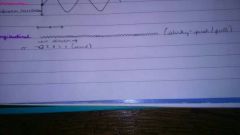![]()
![]()
![]()
Use LEFT and RIGHT arrow keys to navigate between flashcards;
Use UP and DOWN arrow keys to flip the card;
H to show hint;
A reads text to speech;
43 Cards in this Set
- Front
- Back
- 3rd side (hint)
|
What is the peak of a wave? |
The highest point of a wave. |
|
|
|
What is the trough of a wave? |
The lowest point of the wave. |
|
|
|
What is the amplitude? |
The maximum displacement from the equilibrium. |
|
|
|
What is a wavelength? |
The distance between two like points eg. peak to peak. |
|
|
|
What is the wave height? |
The distance between the peak and the trough of a wave. |
|
|
|
How do transverse waves travel? |

At 90 degrees to the vibrations which caused them. |
|
|
|
How do longitudinal waves travel? |

Parallel to the vibrations which caused them. |
|
|
|
Examples of transverse waves... |
-Light -Slinky moved up and down -Mexican -Water -Electromagnetic spectrum |
|
|
|
Examples of longitudinal waves... |
-Sound -Slinky pushed/pulled |
|
|
|
What is the frequency? |
How many waves pass a point per second. |
|
|
|
Symbol for frequency? |
f |
|
|
|
What is frequency measured in? |
Hertz (Hz) |
|
|
|
What is the time period? |
How long it takes for one wave to pass. |
|
|
|
What is the symbol for time period? |
T |
|
|
|
What is time period measured in? |
Seconds (s) |
|
|
|
Equation for frequency... |
f=1/T (frequency=1/time period) |
|
|
|
What is the equation for time period? |
T=1/f (time period=1/frequency) |
|
|
|
What is the symbol for wave speed? |
V (or C) |
|
|
|
What is wave speed measured in? |
m/s |
|
|
|
What is the symbol for wavelength? |
Lamda |
|
|
|
What do you measure wavelength in? |
metres (m) |
|
|
|
What is the equation for wavelength? |
V=f x lamda |
|
|
|
What do waves transfer? |
Energy or information but not matter. |
|
|
|
What type of wave is sound? |
Longitudinal. |
|
|
|
What is sound produced by? |
Oscillating objects. |
|
|
|
What can Hz humans hear between? |
20-2000 Hz. |
|
|
|
How do you measure the speed of sound? |

|
Microphones |
|
|
How do you measure the speed of sound? |

|
Lightning |
|
|
How do you measure the speed of sound? |

|
Gun |
|
|
What is the Electromagnetic Spectrum? |
A continuous spectrum of waves that have different wavelengths and different properties. |
|
|
|
All electromagnetic waves... |
-are transverse -travel at the speed of light (300000000 m/s {300 million m/s}) -can travel through a vacuum |
|
|
|
What is the order of the Electromagnetic Spectrum? |
Radio Micro Infrared Visible Ultra-violet X-ray Gamma Gamma Gamma Gamma Gamma Gamma |
-increasing frequency -increasing energy -decreasing wavelength RED MONKEYS IN VIETNAM USE XYLOPHONES GREATLY |
|
|
Use of radio (electromagnetic spectrum)... |
Communication - TV, radio, walkie-talkies |
|
|
|
Use of micro (electromagnetic spectrum)... |
Satellite, heating effect used in microwave ovens |
|
|
|
Use of infrared (electromagnetic spectrum)... |
Radiant heaters and grills, TV remote controllers, security alarms and lamps, night vision |
|
|
|
Use of visible (electromagnetic spectrum)... |
ROYGBIV - only type of radiation visible to the eye |
|
|
|
Use of ultra-violet (electromagnetic spectrum)... |
Causes tanning, skin cancer, eye damage, causes fluorescence, kills bacteria, security marking |
|
|
|
Use of x-ray (electromagnetic spectrum)... |
X-ray photography, causes fluorescence, causes cancer, can kill cancer cells |
|
|
|
Use of gamma (electromagnetic spectrum)... |
Emitted by radioactive materials, used for sterilising medical equipment and food |
|
|
|
Dangers of electromagnet spectrum... |
-Over exposure to certain types of electromagnetic radiation can be harmful cause -Microwaves cause internal heating of body tissues -Infrared radiation is felt as heat and causes skin burns -The higher the frequency of the radiation, the more damage it is likely to cause -Microwaves cause internal heating of body tissues-Infrared radiation is felt as heat and causes skin burns-X-rays damage cells, causing mutations (can lead to cancer) and cell death-Gamma rays also damage cells, causing mutations (could lead to cancer) and cell death -X-rays damage cells, causing mutations (can lead to cancer) and cell death -Gamma rays also damage cells, causing mutations (could lead to cancer) and cell death |
|
|
|
What happens to waves that diffract? |
They bend round the sides of an obstacle, or spread out as they pass through a gap. |
|
|
|
When is diffraction significant? |
Diffraction is only significant if the size of the gap is about the same as the wavelength. Wider gaps produce less diffraction. |
|
|
|
Draw a diagram of how diffraction works. |

Waves spread out. |
|

